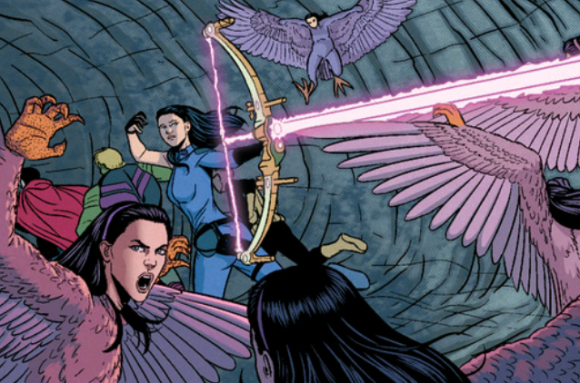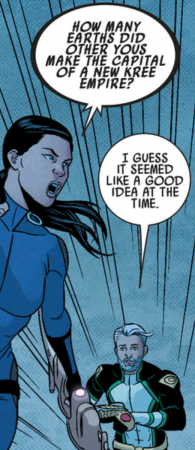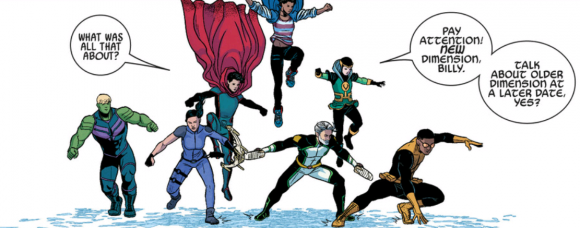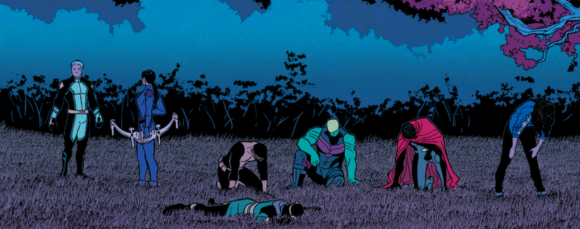 Marvel comics exist as part of a very extensive meta-verse, a plethora of multiplicities which, in canon, play out many scenarios and worlds. It’s extensive, pervasive mechanic to the way things work in the comics, affecting technologist and magic-using superheroes alike,
Marvel comics exist as part of a very extensive meta-verse, a plethora of multiplicities which, in canon, play out many scenarios and worlds. It’s extensive, pervasive mechanic to the way things work in the comics, affecting technologist and magic-using superheroes alike,
I know it’s by no means unique to Marvel but there is something fantastic about a fictional multiverse that embraces its own multiplicity, which throws itself wholesale upon the principle that every event is a branching, that there must be thousands of variants on every element of minutiae. It’s partly interesting to me because it makes fanfiction meta-canon and partly interesting because it gives creatives an excuse to go apeshit fucking ball-crazy.
Warning: some little spoilers for Young Avengers #8 ahead
Apeshit fucking ball-crazy isn’t quite what I mean, actually. One of the amazing things about the many worlds theory, as a bit of quantum physics, is that it’s basically an excuse for all the whimsical stuff you can’t even conceive of to be considered valid and maybe viable. Also for all the things that flutter on the edge of your consciousness, which you know couldn’t possibly be in this particular world but must be out there, somewhere. Hopefully without a method of transfer.
The thing about lots of universes (and this is something that, at its convenience and without any enormous mind for physics, Marvel does a lot) is that not all of them will actually be an ongoing concern- sometimes, the Schroedinger’s cat is dead. Sometimes they’re fully formed worlds with hundreds of comics about them, sometimes they’re a half-mention in a dodgy old Excalibur comic (“If you use this as an opportunity to bang on endlessly about Excalibur, yer fired” -Editor Sat-yr-9) and sometimes they’re a playful what if. They’re a playground and an opportunity and a feast, a collapsible pocket of hell or a sustained companion piece.
I have been, as you can imagine, fairly excited by the fact that there seemed to be a decent amount of cross-dimensional capability in the current Young Avengers line up. When they kicked off with a little interdimensional wrongcockery and some rescue mission through space-time my interest was somewhat piqued and it’s all massively paid off with the absolute motherlode of multiversal roadtripping this issue.
This issue was the Young Avengers as a team unit- it’s partly because they’ve had time to get used to punching each other properly but also a steady development, in terms of the way they appear, from each issue to the next. There were five or six beautiful team panels in #7 but in this issue, they were all together all the time. Huddle formation.
They’re looking at each other, now, looking to each other and staying close in. Thousands of dimensions away, without even Noh-Varr’s ship full of dreams, this is a thousand gritty realities and probably a fair number where even the absence of grit is deeply uncanny. There’s a late teenage lurch from family to found-family that’s been a central mechanic to Young Avengers all the way back to the start of volume one but this closeness in the vastness is about control of variables. In the way that young lovers want to stay together forever (and sometimes do) and friends get tattoos together when they’re leaving for university, at moments of young flux and decision making you cling to people having to make parallel decisions with you. Which only becomes more essential when the parallel universes those choices spark might be where you eat next. Together forever no matter how hard it seems, no matter how much they punch each other. Especially when it’s just to make sure they’re really there.
To breeze through a sufficient number of worlds in this issue to show where they’d been, while giving a sense of what the worlds are and creating a coherent flow from portal to portal was always going to be a challenge and to keep it witty and touching while doing so isn’t just a case of drawing some things in a row.
I’ve been meaning to talk about Jamie McKelvie’s beautiful art for this series since I started writing these things and somehow ended up mostly sidetracked onto splurging feelings about characters. Most of my feelings are deeply linked to the art, of course but even so, I wanted to explicitly talk about how fucking amazing the art has been.
McKelvie’s well known for being a very detailed, expressive artist but to say he knocked it out of the ballpark and probably into a frightening dimension where it got chewed up and we don’t want to go and ask for it back from this issue would be an understatement. There are so many panels here that are made emotive pauses by the way he’s drawn the characters- take Kate hiding from Noh-Spidarr up above, capable-looking but visibly ill-at-ease, shaken in the way that someone who’s seen too much to be particularly shocked but still doesn’t like what they’re seeing right now is. The panel’s great anyway, because spider-head Technoh-Varr is awesome but Kate’s positioning and expression make it a pause, a distinct world.
Then there’s this-
First thing you see is the Asgardian skeletons, the emblem of the enthroned, shattered Mjolnir and slumped over Lorelei (Sigyn? Not sure, they both had armbands) and of course, Loki’s tears. It’s an obviously bleak scene, a failed world and you could almost leave it at that except that because of where this issue is, thematically, Jamie’s packed another two characters in. Wiccan- horrified and fascinated, terrified and unleashing his inner Norse nerd and dear gods that sliver of America.
This is a character we haven’t seen do much apart from be indestuctibly badass. Even when they faced certain doom against Mother, Chavez was going down without a whimper. But that little strip of her face is not exactly naked fear -in fact, kind of the opposite- a complete drop of her ballsy self-assurance to a guarded alert. That tiny bit of her face has more expression in than things I’ve spent weeks on- I’m both disgustingly jealous of McKelvie’s talent and doing a little bit of a drool.
 Expressions are important where the content is fantastical- there’s a whole set of incredibly talented artists at Marvel at the minute, many of whom stand out for their ability to create astounding emotive moments through aesthetic (Dalibor Talijic, Frazer Irving, Filipe Andrades, Francesco Francavilla to name a few) and astoundingly detailed expressions (Valerio Schiti, Sara Picheli, Stuart Immonen, Chris Bachalo) and Jamie has brought the best of his own gorgeous, clean stylised lines and an ambitious superheroic chemistry to this. The striking double-page spreads in each issue have been terrific and there aren’t any of them I wouldn’t extremely gladly buy as a print but with the time/space scope of issue #8 being so enormous, it’s the incredible detail put into each panel here that makes it work as narrative.
Expressions are important where the content is fantastical- there’s a whole set of incredibly talented artists at Marvel at the minute, many of whom stand out for their ability to create astounding emotive moments through aesthetic (Dalibor Talijic, Frazer Irving, Filipe Andrades, Francesco Francavilla to name a few) and astoundingly detailed expressions (Valerio Schiti, Sara Picheli, Stuart Immonen, Chris Bachalo) and Jamie has brought the best of his own gorgeous, clean stylised lines and an ambitious superheroic chemistry to this. The striking double-page spreads in each issue have been terrific and there aren’t any of them I wouldn’t extremely gladly buy as a print but with the time/space scope of issue #8 being so enormous, it’s the incredible detail put into each panel here that makes it work as narrative.
The panel to the left here is my favourite. Maybe of anything. It’s Kate’s ‘good-god-what-now’ expression, Noh-Varr’s look of genuine guilt mixed with some sort of back-of-the-mind appreciation that hey, that’s a lot of empires and also fond recognition of the inevitable horrible that’s attacking them at the time. This is the shouted conversation of people who know each other close enough to be able to rub each other any number of ways, a clear evolution from their affectionate-but-distant exchanges even two issues ago, when Noh-Varr was still calling her Kate Bishop of Earth, even playfully. (I guess the question now would be ‘which Earth?’)
I have to confess to not actually understanding exactly the relationship between artist and inker (I am from the manga, m’lud, I assume they are the same person) but assuming Matthew Wilson is doing all the colours for this then he also deserves a colossal pat on the back for issue #8; each new world has a distinct palette and tone, even the one where the point kind of is that it doesn’t have one and the decisions about when to use eye-popping boldness and when to fade into muted solemnity, each creating a dramatic tension, are perfectly executed.
As to what actually goes on, beyond the dimension hopping; I’m hopeful that the next six months are going to see a lot of smooching, even more punching and quite a lot of traumatic tentacle horror. And maybe the rabbits, we haven’t actually had a chance to get a look at those yet.




I’ve been wondering for some time – what do you actually think the many-worlds theory is? And how many is many?
Incalculable. I can’t seem to paste a link in here but basically Hugh Everett’s principle that each branch in each world spawns infinite new worlds, each performing other outcome possibilities. I don’t know it it was him who determined there must also be failed instances but on a quantum evolutionary level it seems certain there must be, if you subscribe to reality as nonlinear or multilinear. I’m probably not explaining this very well but I do honestly know what it is, it’s my favourite bit of comforting science.
I know it’s normally applied to quantum behaviour as an actual principle that means something more than handwave-y but on a fictional level I like this broader strokes form.
Humm. I have got angsty about whether I’m applying the physics wrong, now. I don’t think I am, though- I’m talking about it here as something abstracted to metaphor, rather than as a lecture.
Obviously the Many Worlds Interpretation is much more vast and precise than Marvel’s occasional ventures into theoretical branching. The MWI works on the principle that there are ever constantly expanding worlds created within a universe, folding out concertina-d and collapsing in again (if they simultaneously reach a fail point) and all of this happening as a fractal from the subatomic (and indeed, sub-sub-atomic) level onwards. A world could be a brief and extinguished flash of particles, one particle, one not-even-really-a-particle or it could be a whole apparent system of galaxies, according to the MWI and all of them are as branchable and collapsible from their fractal origin. (The fractal origin being one of the great mysteries of science but like, let’s assume it’s a previous collapse point)
The way that Marvel applies that is goofy, not hard-scientific but it’s also not directly contradictory, the travel between worlds aside. I don’t mean that the Siege Perilous is a beautiful illustration of the apex of modern quantum theory because obviously that would be nonsense but the replicating, conflicting riot of tiny or extensive worlds and the fact they’re called worlds (well, earths, which is different but at least not ‘universes’) is all kind of pleasingly close to the mark on a philosophical level.
I like the idea of unfolding concertina universes represented as lots of stacking, endlessly generating panels- billions per second, like a flickbook CERN couldn’t hope to see the page edge on. But that’s just visual whimsy.
(Something I nearly decided to talk about here but cut for leaning too hard on the ‘this is actual physics’ not ‘this is a beautiful and awesome illustration of physics’ was that America’s ability to travel between other worlds via that stamp could be seen as representative of the ‘weak coupling’ theory for inter-world travel, whereby localized gravity could push things together. Like, if she has the ability to borrow mass from a star through those glowing markings so that she could temporarily curve space enough to break through. This is obviously into like, hyper-stupid overinterpretations since the weak coupling idea would be that maybe a small amount of energy could pass through, not a whole superhero team but HEY several of these people can fly let’s not think about it too hard)
If anyone wants to know more about MWI from a serious scientific perspective then this is a pretty good, thorough site:
http://www.hedweb.com/manworld.htm
“I have to confess to not actually understanding exactly the relationship between artist and inker (I am from the manga, m’lud, I assume they are the same person)”
If you’re from the manga, they’re more likely to be a dozen people, uncredited!